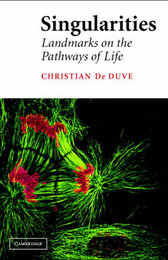
|
Singularities: Landmarks on the Pathways of Life
Hardback
Main Details
| Title |
Singularities: Landmarks on the Pathways of Life
|
| Authors and Contributors |
By (author) Christian de Duve
|
| Physical Properties |
| Format:Hardback | | Pages:274 | | Dimensions(mm): Height 236,Width 164 |
|
| Category/Genre | Genetics (non-medical)
Cellular biology (cytology) |
|---|
| ISBN/Barcode |
9780521841955
|
| Classifications | Dewey:572.838 |
|---|
| Audience | | Professional & Vocational | | General | | Tertiary Education (US: College) | |
|---|
| Illustrations |
15 Halftones, unspecified
|
|
Publishing Details |
| Publisher |
Cambridge University Press
|
| Imprint |
Cambridge University Press
|
| Publication Date |
24 October 2005 |
| Publication Country |
United Kingdom
|
Description
Erwin Schroedinger's What is Life? published 60 years ago, influenced much of the development of molecular biology. In this new book Christian De Duve, Nobel Laureate and pioneer of modern cell biology, presents a contemporary response to this classic, providing a sophisticated consideration of the key steps or bottlenecks that constrain the origins and evolution of life. De Duve surveys the entire history of life, including insights into the conditions that may have led to its emergence. He uses as landmarks the many remarkable singularities along the way, such as the single ancestry of all living beings, the universal genetic code, and the monophyletic origin of eukaryotes. The book offers a brief guided tour of biochemistry and phylogeny, from the basic molecular building blocks to the origin of humans. Each successive singularity is introduced in a sequence paralleling the hypothetical development of features and conditions on the primitive earth, explaining how and why each transition to greater complexity occurred.
Reviews'... fine, incisive prose. ... [De Duve] takes us on a dazzling trip within a cell, providing a beautiful exposition of life's biochemical cycles, their elegance, equilibrium and evolution.' New Scientist 'Christian de Duve gives his readers generous transparency in laying bare his reasoning and in the aesthetics of his current attempt at hard and beautiful problems concerning the unitary features of life and their origin. Few books allow this continuity of thinking over sucha broad range of interrekated problems.' BioEssays '... we should always be alert to the great problems, such as understanding the processes leading to the origin of life. Given past experience, such great questions will be solved - not by chance but by the prepared mind. This book is a start to preparing that mind.' Nature
|